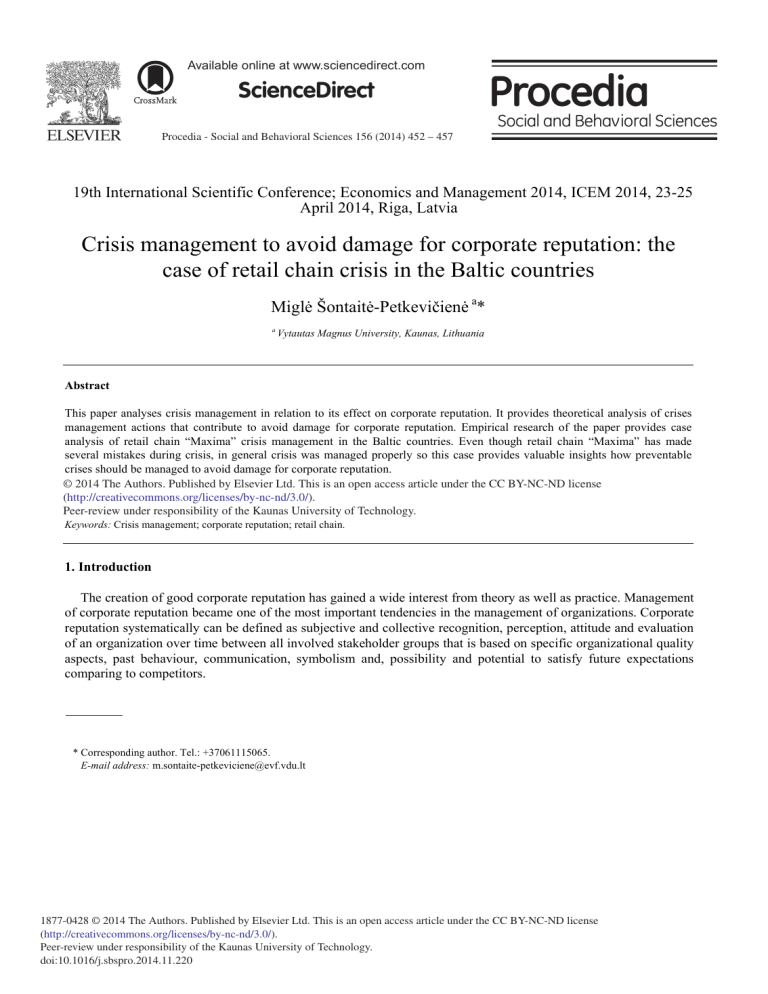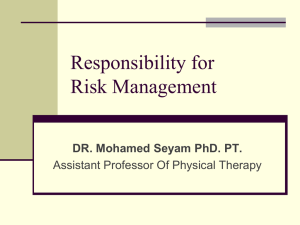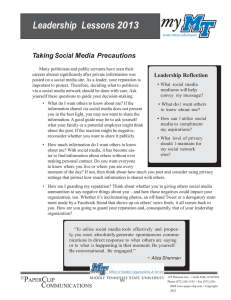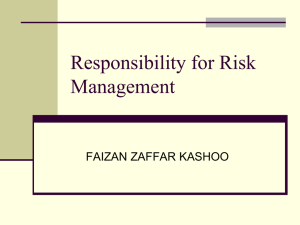
Available online at www.sciencedirect.com ScienceDirect Procedia - Social and Behavioral Sciences 156 (2014) 452 – 457 19th International Scientific Conference; Economics and Management 2014, ICEM 2014, 23-25 April 2014, Riga, Latvia Crisis management to avoid damage for corporate reputation: the case of retail chain crisis in the Baltic countries Miglơ Šontaitơ-Petkeviþienơ a* a Vytautas Magnus University, Kaunas, Lithuania Abstract This paper analyses crisis management in relation to its effect on corporate reputation. It provides theoretical analysis of crises management actions that contribute to avoid damage for corporate reputation. Empirical research of the paper provides case analysis of retail chain “Maxima” crisis management in the Baltic countries. Even though retail chain “Maxima” has made several mistakes during crisis, in general crisis was managed properly so this case provides valuable insights how preventable crises should be managed to avoid damage for corporate reputation. © 2014 2014 The The Authors. Authors. Published Publishedby byElsevier ElsevierLtd. Ltd.This is an open access article under the CC BY-NC-ND license © Peer-review under responsibility of the Kaunas University of Technology. (http://creativecommons.org/licenses/by-nc-nd/3.0/). Peer-review under responsibility of the Kaunas University of Technology. Keywords: Crisis management; corporate reputation; retail chain. 1. Introduction The creation of good corporate reputation has gained a wide interest from theory as well as practice. Management of corporate reputation became one of the most important tendencies in the management of organizations. Corporate reputation systematically can be defined as subjective and collective recognition, perception, attitude and evaluation of an organization over time between all involved stakeholder groups that is based on specific organizational quality aspects, past behaviour, communication, symbolism and, possibility and potential to satisfy future expectations comparing to competitors. * Corresponding author. Tel.: +37061115065. E-mail address: m.sontaite-petkeviciene@evf.vdu.lt 1877-0428 © 2014 The Authors. Published by Elsevier Ltd. This is an open access article under the CC BY-NC-ND license (http://creativecommons.org/licenses/by-nc-nd/3.0/). Peer-review under responsibility of the Kaunas University of Technology. doi:10.1016/j.sbspro.2014.11.220 Miglė Šontaitė-Petkevičienė / Procedia - Social and Behavioral Sciences 156 (2014) 452 – 457 Corporate reputation has intangible value for organizations and is the most important strategic and long-term organizational asset. Corporate reputation provides opportunities to organizations in developing and retaining market share, influencing opinion of customers and other stakeholder groups. However, organizations aren’t resistant to controlled and uncontrolled incidents that can diminish corporate reputation. For this reason, organizations shouldn’t have doubts on the critical effect of negative actions and incidents towards the loss of good corporate reputation. According to Weiner (2006), few circumstances test a company's reputation or competency as severely as a crisis. Therefore, the focus of this research is crisis management in relation to its effect on corporate reputation. The case of retail chain “Maxima” crisis management in Latvia and Lithuania is selected for the research as it is an example of the most significant crisis in the Baltic countries. The problem of the research – how crisis should be managed endeavouring to avoid damage for corporate reputation. The object of the research is crisis management that contributes to avoid damage for corporate reputation. The objectives of the research are as follows: (1) to analyse crisis management theory that contribute to avoid damage for corporate reputation; (2) to analyse empirically the case of retail chain crisis in the Baltic countries. A crisis is a business or organizational problem that is exposed to public attention, and that threatens a company's reputation and its ability to conduct business (Weiner, 2006). Coombs (2007) agree that a crisis is a sudden and unexpected event that threatens to disrupt an organization’s operations and poses both a financial and a reputational threat. Crises can harm stakeholders physically, emotionally and/ or financially. A wide array of stakeholders are adversely affected by a crisis including community members, employees, customers, suppliers and stockholders. During crises effective crisis management has a significant importance endeavouring to avoid damage for corporate reputation. Weiner (2006) notes that a crisis can take on many forms, including natural or man-made disasters, environmental spills, product tampering or recalls, labour disruptions or criminal acts to name a few. Payne (2006) believe that the interaction of reputation and response may be such that traditional strategies do not apply in all cases For this reason, Grundy, Moxon (2013) suggest when considering an appropriate crisis response, organisations must assess the type and scale of crisis they are facing. Literature suggests three important aspects of crisis management endeavouring to avoid damage for corporate reputation: the role of CEO, organizational activities and communication strategy. According to Turk et al. (2012), positive relationships between a company and its stakeholders plus a CEO who plays a visible leadership role during a crisis may allow for a more aggressive, yet defensive communications strategy during a crisis. There is the interconnectedness of reputation, leadership and communication. So there is a need for a CEO to play a visible leadership role during a crisis, a long-held tenet of crisis management. However, Coombs (2007) believes the first priority in any crisis is to protect stakeholders from harm, not to protect the reputation. To be ethical, crisis managers must begin their efforts by using communication to address the physical and psychological concerns of the victims. It is only after this foundation is established that crisis managers should turn their attentions to reputational assets. There is a body of research that gives scholars and practitioners models to determine the most appropriate crisis response to avoid damage for corporate reputation. Appropriate communication strategy has a significant role in repairing corporate reputation and preventing the organization from reputational damage. Research of Coombs (2007) provides valuable information for organizations how to communicate during crisis. The above mentioned author created Situational Crisis Communication Theory (SCCT) that provides an evidence-based framework for understanding how to maximize the reputational protection afforded by post-crisis communication. According to SCCT three factors in the crisis situation shape the reputational threat: (1) initial crisis responsibility, (2) crisis history (whether or not an organization has had a similar crisis in the past) and (3) prior relational reputation (how well or poorly an organization has or is perceived to have treated stakeholders in other contexts). SCCT research has identified three crisis clusters based upon attributions of crisis responsibility by crisis type: (1) the victim cluster has very weak attributions of crisis responsibility and the organization is viewed as a victim of the event; (2) the accidental cluster has minimal attributions of crisis responsibility and the event is considered unintentional or uncontrollable by the organization and (3) the intentional cluster has very strong attributions of crisis responsibility and the event is considered purposeful. Moreover, Claeys, Cauberghe (2012) distinguished two types of crisis communication strategies: (1) the crisis response strategies and (2) the crisis timing strategies. From the authors’ point of view, selection of crisis response 453 Miglė Šontaitė-Petkevičienė / Procedia - Social and Behavioral Sciences 156 (2014) 452 – 457 454 strategy depends on the amount of crisis responsibility attributed to the organization. The more responsible the organization is, the more responsibility an organization should take in its crisis response. On the other hand, selection of crisis timing strategies depends on the time when crisis response is used. Based on the research results of various authors, Claeys, Cauberghe, Vynche (2010) distinguished a match between crisis types and crisis response strategies (see Table 1). According to Coombs (2007), deny strategies attempt to remove any connection between the organization and the crisis. The diminish crisis response strategies argue that a crisis is not as bad as people think or that the organization lacked control over the crisis. Rebuild strategies are the main avenue for generating new reputational assets. Rebuild strategies attempt to improve the organization’s reputation by offering material and / or symbolic forms of aid to victims. The crisis managers say and do things to benefit stakeholders and thereby take positive actions to offset the crisis. Offering compensation or a full apology both are positive reputational actions. Table 1. Match between crisis types and crisis response strategies to avoid damage for corporate reputation Crisis types Victim cluster Natural disaster Rumour Workplace violence Product tampering/ Malevolence Accidental cluster Challenges Technical-error accidents Technical-error product harm Preventable cluster Human-error accidents Human-error product harm Organizational misdeed with no injuries Organizational misdeed management misconduct Organizational misdeed with injuries Crisis response strategies Deny strategies Attack the accuser Denial Scapegoat Diminish strategies Excuse Justification Rebuild strategies Compensation Apology Source: Claeys, Cauberghe, Vynche (2010). Claeys, Cauberghe, Vynche (2010) emphasize there are two main effects for crisis type and crisis response in relation to organizational reputation. First, corporate reputation is least favourable when organizations are confronted with a preventable crisis. There is no significant difference in reputational perceptions between the accidental crisis and the victim crisis. Second, there is a main effect of crisis response strategy on organizational reputation. Specifically, the reputations of organizations using rebuild crisis response strategies are more positive than the reputations of organizations using diminish strategies. However, Verhoeven et al. (2012) argue that crisis response strategy does not significantly affect people’s responses to the crisis in terms of trust and reputation. Therefore, this research aims at exploring how crises are managed in theory and practice endeavouring to avoid damage for corporate reputation. 2. Method This research adopts the case study approach to explore the current state of crisis management in the retail chain sector. The case of retail chain “Maxima” crisis management in Latvia and Lithuania is selected for the research as it is an example of the most significant crisis in the Baltic countries. On the other hand, retail chain “Maxima” was selected as the overall case study because it is a strong, well-established brand and has a biggest market share in Lithuania. The above mentioned retail chain has faced a number of small organisational or reputational crises over recent years that are mostly associated with the quality of products and relations with employees. However, the crisis that occurred in Latvia in 2013 may be considered as the biggest crisis in the retail sector. Furthermore, this crisis is well covered by the news media enabling a substantial amount of press materials to be obtained. The case study of retail chain “Maxima” crisis management in Latvia and Lithuania is based on the information and interviews with representatives of “Maxima” provided by various Lithuanian and international media: TV, Miglė Šontaitė-Petkevičienė / Procedia - Social and Behavioral Sciences 156 (2014) 452 – 457 455 newspapers, magazines, news portals on the internet, blogs, etc. Press releases by retail chain “Maxima” and its website were also examined in depth. 3. Results “Maxima” is a retail chain operating in Lithuania, Latvia, Estonia and Bulgaria. “Maxima” is a Lithuanian capital company that operates 500 supermarkets and convenience stores throughout Eastern Europe and has a workforce of over 29,000 people, making it the largest employer in the Baltics. Crisis. On 21st of November, 2013 the roof of “Maxima” supermarket in the west Riga neighborhood of Zolitnjde collapsed, killing 54 people and injuring dozens more. The roof of “Maxima” supermarket fell on customers during peak shopping hours around 6:00 pm. The tragedy shook both Latvia and Lithuania as it is considered the deadliest accident to befall the Baltic state since 1991. This tragedy called into question the safety of other shopping centers of “Maxima” in Latvia and Lithuania. Other aspects of mismanagement were brought into light as well: bad working conditions, small salaries, disregard of safety requirements, etc. After it was officially confirmed that tragedy was caused by faulty construction solutions and the company that built this shopping center is associated with “Maxima”, most of the society assigned full responsibility for the tragedy to “Maxima”. Therefore, this crisis must be considered as preventable and human-error accident which claimed political responsibility and caused resignation of Latvian Prime Minister. Initial crisis response. 30 minutes after the tragedy managers of “Maxima” arrived to place, Head of “Maxima Latvia” G.Jasinskas – later in the evening and General Director of “Maxima Group” M.Bagdonaviþius – next morning. After the tragedy, “Maxima” offered psychological consultations to employees of “Maxima”, provided food and drinks for those working at the spot. Presence of “Maxima” managers at the spot of tragedy was very important. On the other hand, care of people involved in the tragedy is the most important lesson in crisis management. The next day “Maxima” invited media to the press conference in Latvia and removed all advertising from internet, printed media and TV. Instead of advertising, condolences in black frame were released. From crisis management point of view, press conference must have been organized the same day of the tragedy so “Maxima” was too late. I.Staškeviþius, Member of the Board at “Vilniaus Prekyba” and Head of later established Crisis Management Group admitted that shareholders were too late with apologies and with getting involved in the management of crisis. Moreover, Head of “Maxima Latvia” G.Jasinskas inappropriately expressed opinion in the sorrow and difficult time for Latvia during crisis. His statements angered Latvia, which summoned Lithuanian ambassador to Latvia to the Latvian Foreign Ministry for explanations. Shortly after, “Maxima” announced that G.Jasinskas has been fired. However, research results of Claeys, Cauberghe (2014) highlights the importance of a right crisis response because a matched crisis response strategy positively influences the post-crisis attitudes toward the organization of consumers with high crisis involvement as compared to a mismatched crisis response strategy. First day after tragedy “Maxima” also announced it will cover all cure and rehabilitation expenses, provide money for burial and all support necessary for injured ones. Second day after tragedy “Maxima” announced it will provide aliments to children who lost parents during the tragedy until they will be 18 years old. Post-crisis response. Few days after the tragedy “Maxima” established Crisis Management Group and assigned I.Staškeviþius, Member of the board at “Vilniaus prekyba”, to manage it. The group coordinated assistance to victims of the tragedy, also handled communications with all institutions and provided information to the public. I.Staškeviþius, reacted to the incident ‘in a friendly manner’ by appearing in various TV shows and giving interviews to journalists. His role in “Maxima” crisis management was positive; however other top managers were doing mistakes. For example, I.Biveinytơ, Chair of the Board at “Vilniaus prekyba”, gave an interview in a very rude manner which could be described as aggressive defense, cold logics, and no heart. As a result of the crisis “Maxima” was forced to stop using its corporate slogan “Thought about everything”. After crisis “Maxima” stopped using the slogan in advertising, deleted it from the webpage and announced the new slogan will be introduced soon as the old one no longer fits “Maxima”. Corporate reputation analysis. “Maxima” admitted that even though the decline of customers wasn’t significant after crisis, its corporate reputation did suffer. M.Bagdonaviþius, General Director of “Maxima Group” believed that Miglė Šontaitė-Petkevičienė / Procedia - Social and Behavioral Sciences 156 (2014) 452 – 457 456 the company was not ready to deal with a crisis of such magnitude and, therefore, made mistakes. He expressed hope with time to be able to restore its reputation and confidence. However, some partners, like PR agency that worked with “Maxima Latvia” for eight years, refused to work together anymore because of the disregard to Latvian society. Shockingly arrogant remarks of I.Biveinytơ and G.Jasinskas, even caused intervention of A.Bơrzinis, The President of Latvia, to discuss the issue with D.Grybauskaitơ, The President of Lithuania. According to research made every year by PR agency “Burson Marsteller”, in 2011-2013 “Maxima” was ranked as number one organization with the best corporate reputation in Lithuania. However, due to magnitude of crisis and painful mistakes there are doubts if “Maxima” will retain corporate reputation of the same level after crisis. 4. Conclusions Crises happen unexpectedly and can destroy good corporate reputation immediately. Organizations of all types and sizes should take crisis management seriously and have at least basic knowledge on this issue as crises are considered as one of the biggest threats for corporate reputation. Coombs (2007) notes that crises threaten to damage reputations because a crisis gives people reasons to think badly of the organization. If a reputation shifts from favourable to unfavourable, stakeholders can change how they interact with an organization. Furthermore, stakeholders may sever ties to the organization and/ or spread negative word of mouth about the organization. This shows an evident need of further elaboration on such issues as crisis management and its contribution to avoid damage for corporate reputation. This is especially important in the business sector with man-made crises as the response of organization’s representatives to crisis highly influences the damage for corporate reputation from both internal and external stakeholder groups. From crisis management point of view, retail chain „Maxima“ has made several mistakes during crisis: changed the official storyline – i.e. lied or told only partial truth about the crisis; top management was not involved as spokespersons; and, empathy was expressed mostly in a form of monetary payments. However, based on literature analysis results, in general „Maxima“ handled the crisis properly. As „Maxima“ was dealing with human-error accident from preventable crisis cluster it had to use Rebuild crisis response strategy. Rebuild strategies include compensations and apologies which were the main aspects of „Maxima“ crisis management activities. Coombs, Holladay (2009) prove that apologies and compensation strategies are frequently employed in crises and have positive effects on outcomes such as reputation, anger, negative word-of-mouth, and account acceptance. As a result, it can be summarized that „Maxima“ managed its crisis properly and should avoid big damage for its corporate reputation. However, creation and management of good corporate reputation is a very important aspect of organizational activities on a daily basis. Organizations shouldn’t begin thinking about their corporate reputation only after crisis happen. According to Coombs (2007) an organization with a more favourable prior reputation will still have a stronger post-crisis reputation because it has more reputational capital to spend than an organization with an unfavourable or neutral prior reputation. As a result, a favourable prior reputation means an organization suffers less and rebounds more quickly. In conclusion it should be noted that results of this research paper may be applied practically during the times of crises striving to avoid damage for corporate reputation. Research results may be applied by retail chains, shopping centres and organizations of other types at the international and national level. References Claeys, A.S., Cauberghe, V. (2012). Crisis Response and Crisis Timing Strategies, Two Sides of the Same Coin. Public Relations Review, 38, 83-88. Claeys, A.S., Cauberghe, V. (2014). What Makes Crisis Response Strategies Work? The Impact of Crisis Involvement and Message Framing. Journal of Business Research, 67, 182-189. Claeys, A.S., Cauberghe, V., Vyncke, P. (2010). Restoring Reputations in Times of Crisis: An Experimental Study of the Situational Crisis Communication Theory and the Moderating Effects of Locus of Control. Public Relations Review, 36, 256-262. Coombs, W.T. (2007). Protecting Organization Reputations during a Crisis: The Development and Application of Situational Crisis Communication Theory. Corporate Reputation Review, 10, 163–176. Coombs, W.T., Holladay, S.J. (2009). Further Explorations of Post-Crisis Communication: Effects of Media and Response Strategies on Perceptions and Intentions. Public Relations Review, 35, 1-6. Miglė Šontaitė-Petkevičienė / Procedia - Social and Behavioral Sciences 156 (2014) 452 – 457 Grundy, M., Moxon, R. (2013). The Effectiveness of Airline Crisis Management on Brand Protection: A Case Study of British Airways. Journal of Air Transport Management, 28, 55-61. Payne, L.L. (2006). Synthesizing Crisis Communication and Reputation Management. Journal of Promotion Management, 12, 161-187. Turk, J.V., Jin, Y., Stewart, S., Kim, J., Hipple, J.R. (2012). Examining the Interplay of an Organization‘s Prior Reputation, CEO‘s Visibility, and Immediate Response to a Crisis. Public Relations Review, 38, 574-583. Verhoeven, J.W.M., Van Hoof, J.J., Keurs, H.T., Van Vuuren, M. (2012). Effects of Apologies and Crisis Responsibility on Corporate and Spokesperson Responsibility. Public Relations Review, 38, 501-504. Weiner, D. (2006). Crisis Communications: Managing Corporate Reputation in the Court of Public opinion. Ivey Business Journal, 3-4, 1-6. 457


